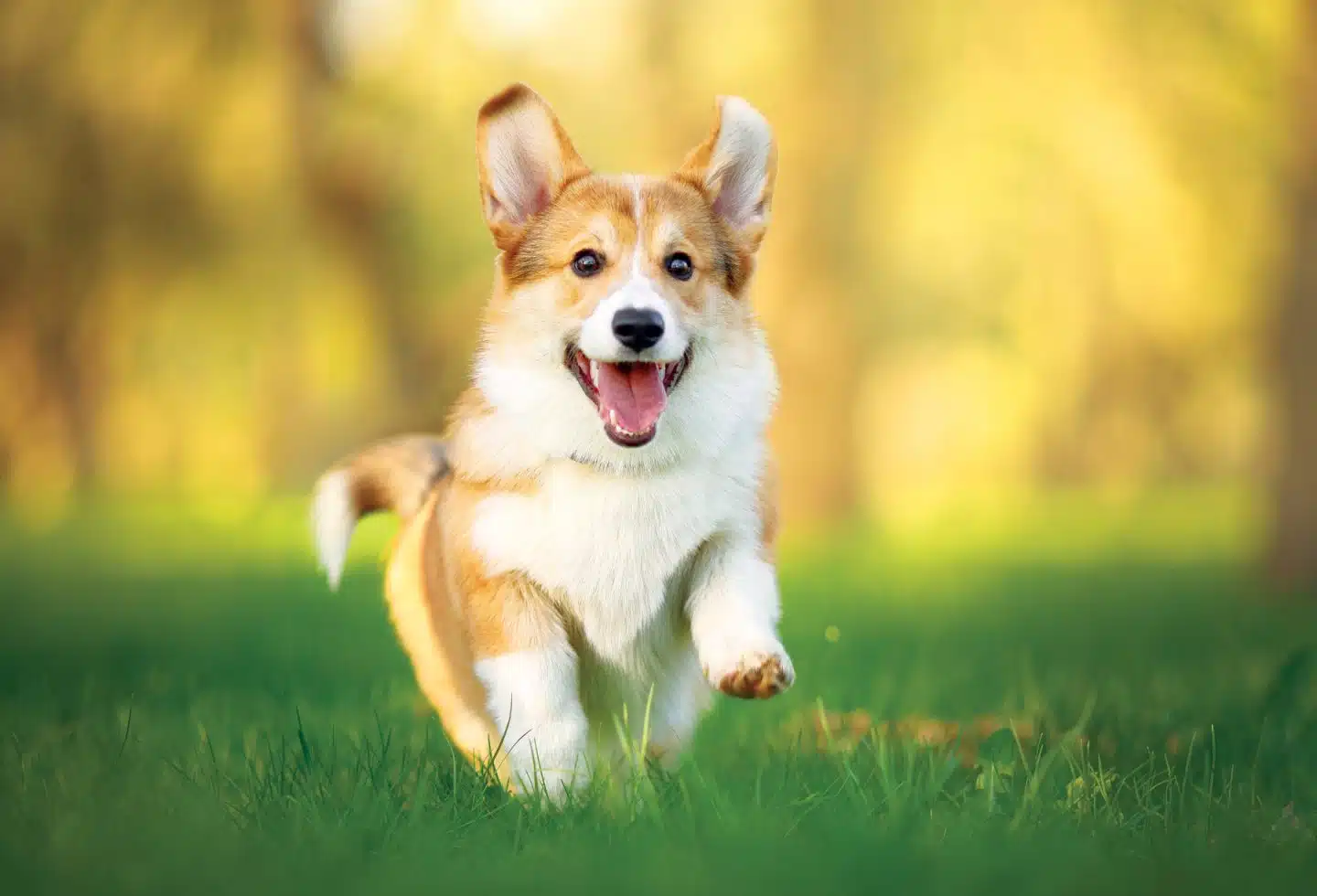Is your dog happy? Experts say there are tell-tale signs to look for that let you know that you have a happy, content dog on your hands.
“Dogs can’t speak to us, but they certainly communicate in other ways, including body language, vocalization, and behaviour,” says veterinarian Dr. Liza Cahn. “A happy dog will generally display relaxed body language, have a good appetite, and joyfully engage in activities with their family members.”
Typical Signs Your Dog Is Happy
As a pet owner, you likely want to ensure that your dog is happy. While some behaviours, like your dog greeting you at the door with a wagging tail, are easy to interpret as happiness, others are a little more complex. Kate LaSala, a multi-credited dog trainer and behaviour consultant says, “Typical signs of a happy or relaxed dog include soft, open mouth, relaxed ears, soft eyes, even body weight, and loose body—but when interacting with a dog, it’s important to look at the dog’s entire body language and communication, not just one thing like a tail wagging.” Read on for 16 signs that indicate that your dog is feeling happy so that you can understand on a deeper level just how your dog is feeling.
Though each dog is an individual and they express themselves in unique ways, there are general cues—some of them subtle—to watch for that will let you know how your dog is feeling. Look for these traits to ensure your dog is feeling fine!

How to Tell If Your Dog Is Happy: 17 Signs to Look For
#1 Look to the Tail
A wagging tail is a common sign of a happy dog. But if your dog’s tail is stiff, standing upright, and wagging rapidly or shortly, it might be a sign that your dog is feeling fearful or aggressive. A happily wagging tail will be relaxed and make broad strokes. Slower broad strokes may indicate that your dog is feeling a bit shy, while faster broad strokes can indicate that your dog is feeling excited. Sally Grottini, Therapy Dog and AKC Evaluator and Trainer, states: “Keep in mind that a tail shows different emotions of a dog which are happiness, alertness, and fear. It is very important to watch all of the dog’s body language to know what they are feeling at the time.”
Direction of the wag counts: a study found that dogs wag their tails to the right when looking at something they want to approach.
Direction of the wag counts too. A scientific team at the University of Trento in Italy found that dogs wag their tails to the right when looking at something they want to approach, such as their owner. But they wag their tails to the left when confronted with something they want to get away from, such as another dog with an aggressive posture.The dogs’ directional tail wagging was a result of increased activation of either the left or right side of their brains, said neuroscientist Giorgio Vallortigara who led the study, reports National Geographic.
#2 Ears to You: the Ear Position of Happy Dogs
Whether your dog has naturally floppy ears or upright ears, loose, relaxed ears can tell you that your dog is feeling happy. Dr. Liza Cahn points out that this means their ears are held in their natural state, without any tension. This differs from ears that are pulled forward, which can indicate that your dog is feeling curious about something or ears that are pulled back, which might be because your dog is feeling nervous.
#3 A Happy Expression (Yes, Dogs Can Smile!)
If you notice that your dog is smiling, they just might be! As Grottini states, “Dogs will often show their moods through body language. If you see a dog with their tail up and fully wagging, their ears and mouth are relaxed, they are showing happiness, also known as the ‘happy face.’” They might also have a loose, lolling tongue. (Note that this differs from a panting dog, which may indicate that your dog is stressed). With a happy dog’s facial expression, you might see their teeth, but their mouth is relaxed, rather than aggressively baring their teeth.
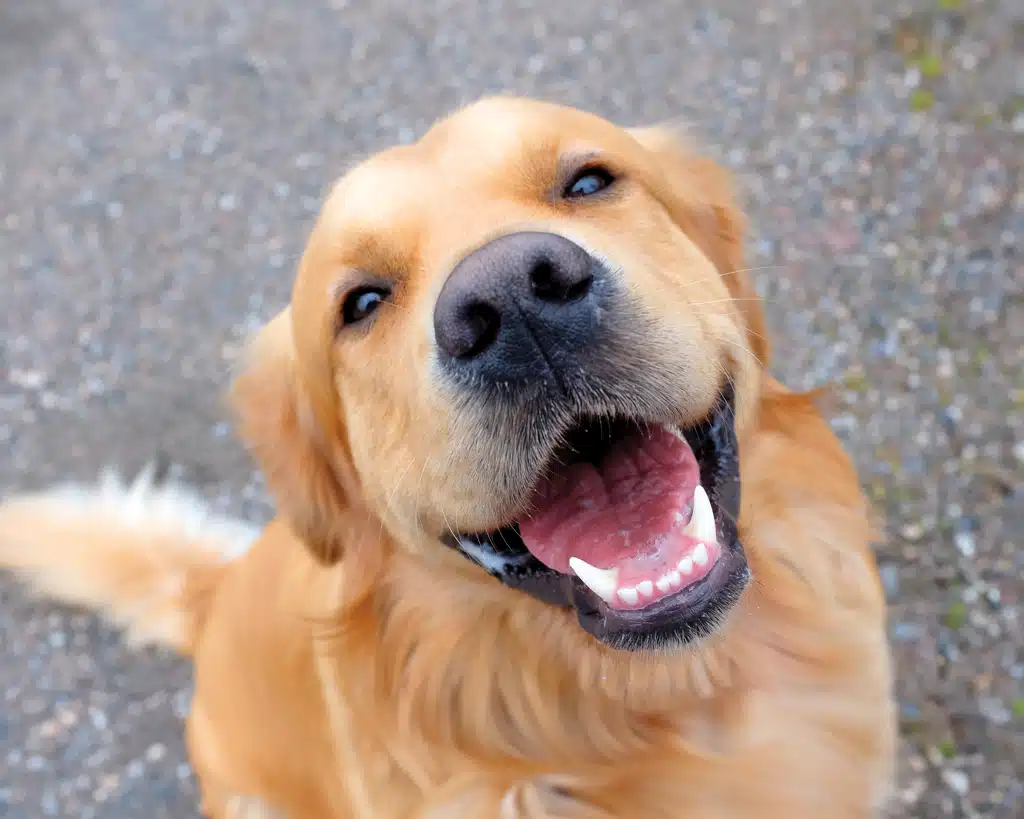
#4 The Wiggle
A happy dog has body language that is relaxed and loose. This might result in a full body wiggle, where they seem to be wagging their whole body. “They may hop/squiggle back and forth, also known as the ‘Happy Dance’,” says Grottini.
#5 Play Bowing
The classic play bow, where your dog has their chest lowered to the ground and their rear end extended up in the air, is a good indication that they are happy and feeling friendly. In fact, A University of Michigan study set out to determine why exactly dogs perform this bowing behaviour. Researchers found that dogs play bow most often when there is a pause in play, and they wish to continue playing. So, if you see your dog play bow in the middle of playing fetch, this gives you a good idea that they’re enjoying what they’re doing and want to play more.
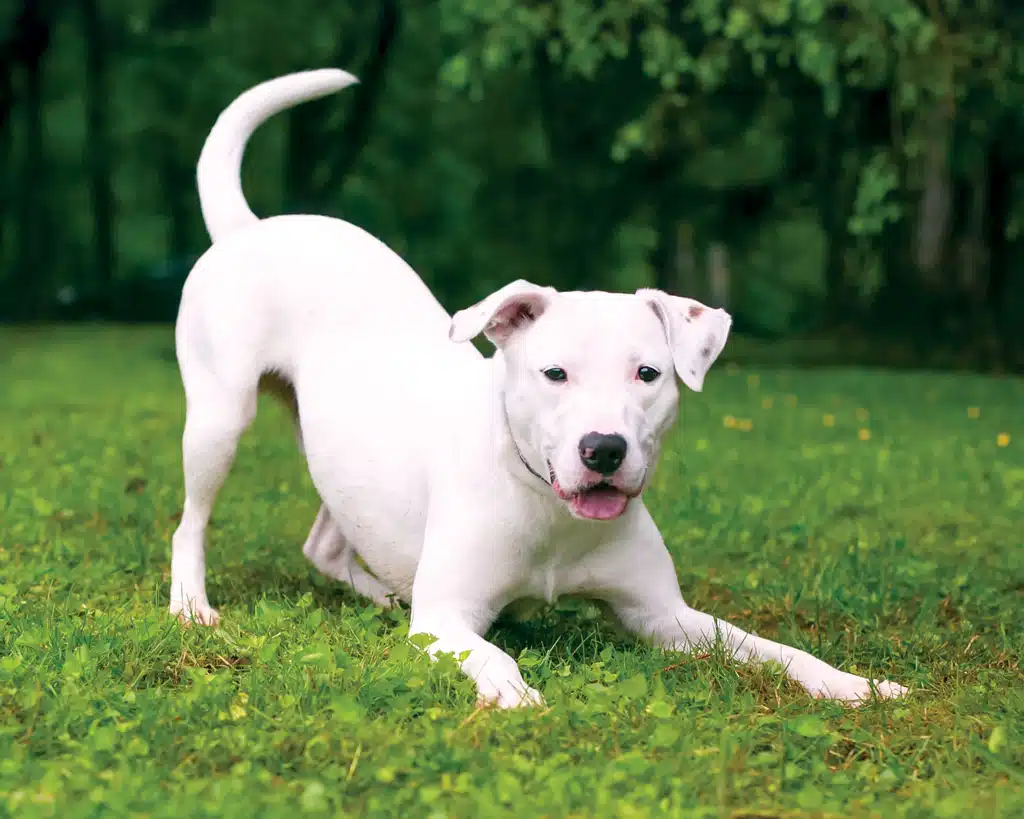
#6 Tummy Time
Because a dog’s belly is a vulnerable spot, when your dog rolls over for a belly rub, they’re indicating that they feel safe and content with you, and are seeking affection. This can also be a sign of submission, intended to indicate that they are not a threat. Grottini points out, “Dogs that are happy are usually more relaxed in their surroundings; they may lie down on their back with their feet in the air.”
#7 Good Behaviour
Destruction can be a sign of anxiety, notes Grottini. So, if your dog is well-behaved, then it can tell you that they’re feeling fulfilled and happy. Dr. Liza Cahn says, “Destructive behaviour in dogs, such as chewing, scratching, and house soiling, can stem from a variety of issues with both behavioural and medical causes. If your dog is exhibiting new destructive behaviours, it’s best to schedule an appointment with your veterinarian to rule out contributing medical issues.” She also points out that separation anxiety, fears or phobias, and lack of mental or physical stimulation are common causes of destructive behaviours, none of which indicate a happy dog.
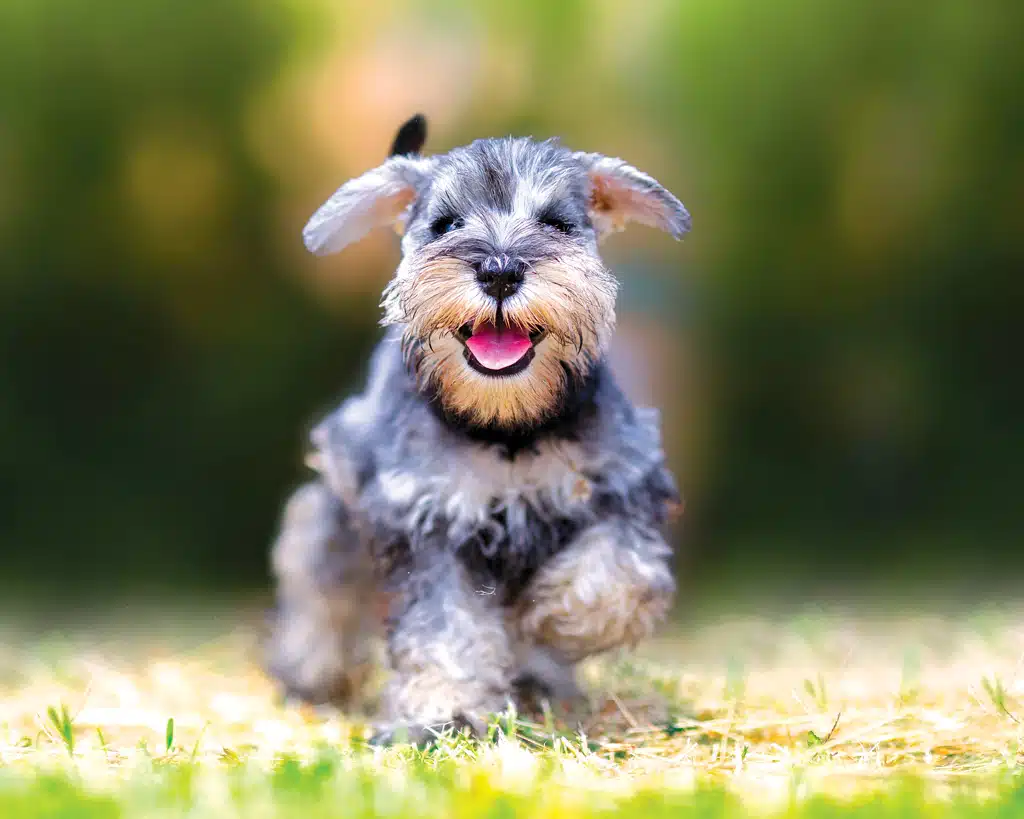
#8 They Get Their Sniff On
If your dog is content, then their enjoyment of walks will be clear. You’ll likely notice a happy, bouncing stride. They’ll also likely stop to participate in enjoyable, calming behaviours like sniffing. This is supported by a 2020 University of Queensland study that looked at improving the well-being of shelter dogs with auditory and olfactory forms of enrichment. They found that shelter dogs who engaged in sniffing behaviours were more likely to show calm, content behaviours like laying down more frequently.
#9 They Seek Affection
Dogs are pack animals, and you are your dog’s pack. A friendly dog who is feeling happy will likely seek out some affection from you at some point. This might be in the form of leaning against you, lying beside you, or asking for pets. “Leaning on you, snuggling, rolling over to request belly rubs, etc. are all behaviours generally associated with a strong human-animal bond, which is key for your dog’s happiness,” says Dr. Liza Cahn.

#10 An Appetite for Life
According to Dr. Liza Cahn, “If your dog is stressed or ill, they may refuse food”. While every dog has different eating habits, it’s important to check that they are consistent. For example, if your dog’s favourite time of the day is dinnertime and they start to show a lack of interest in eating, then it tells you that something else might be going on.
#11 Content Sleep
Healthy adult dog sleeps 12-14 hours per day. If your pup is getting in this much snooze time, then it’s a good sign that they’re feeling fulfilled and content in their daily lives. You’ll also likely notice that their breathing is steady and relaxed while they’re sleeping.

#12 The Body Posture of Happy Dogs: What to Look For
A dog’s happy body posture will be “relaxed, free of tension, or if your dog is excited or engaged in play you may see a play bow or full-body wiggles,” says Dr. Liza Cahn. Stiff body language might mean that they’re on alert or are feeling anxious.

#14 The Zoomies
“[The] play bow, full-body wiggles, and zoomies” are often a sign of healthy dog play, says Dr. Liza Cahn. While zoomies often happen when your dog is feeling excited and needs to release this happy energy, LaSala reminds us that it’s important to consider the context and your dog’s complete body language: “Zoomies are often happy and excited, but they can be a way for a dog to release pent up energy or anxiety.”
A happy dog will have soft, relaxed eyes.
#15 A Soft Gaze
A happy dog will have soft, relaxed eyes. A dog who is feeling stressed might have narrowed eyes, while an aggressive dog is likely to have a hard stare. As LaSala points out, the soft gaze paired with how the dog is carrying their body weight, their ear position, muzzle/mouth tightness and if the dog is being overtly prosocial can help you determine how your dog is feeling overall.
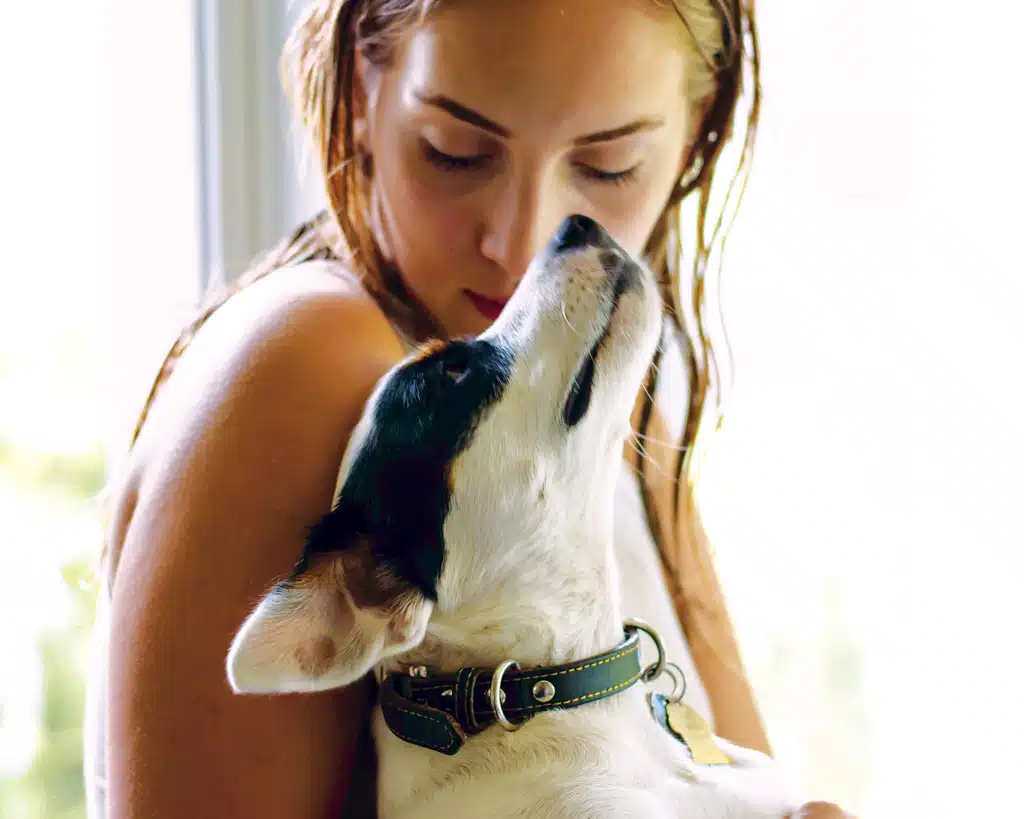
#16 A Healthy, Shiny Coat
How your dog’s feeling is often reflected in their coat. A healthy coat will typically be shiny and smooth. If your dog is shedding excessively, this might mean that they are feeling stressed or are dealing with a medical condition, like allergies.
#17 Vocal Clues: Sounds That Happy Dogs Make
Dr. Liza Cahn says, “Vocalizations should be interpreted in context and along with your dog’s body language and can provide another clue to their emotional state”. She states that short, high-pitched sounds alongside playful behaviours can indicate that your dog is having a good time. If you have a more vocal breed, like a Husky, you might notice that they might sing, chirp, howl, or yodel when they’re in a good mood. You might also notice your dog letting out a content sigh after lying down; this can indicate that they feel safe, happy, and relaxed in your presence.

While these can all be signs that your dog is happy, it’s important to look at your dog’s total body language and consider their unique personality when evaluating how they’re feeling. As Dr. Liza Cahn reminds, “All dogs are individuals, and some may have other ways of showing happiness or contentment. It’s important to be on the lookout for variations from your dog’s norm, which may indicate stress, anxiety, or illness.”
